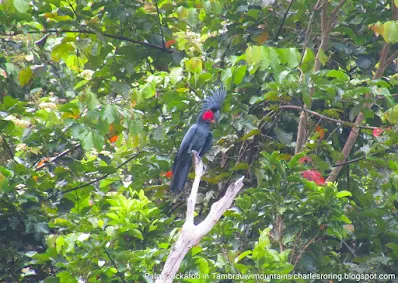 |
| Tambrauw Mountains |
I went to Tambrauw mountains last week to enjoy birding with Ashley - a lady from the United States in Aibogiar forest for 3 days. We went there by a small plane from Manokwari to Kebar and then continued our trip by a 4WD car to Aibogiar. It was a unique experience for me because I could watch Lesser Birds of Paradise and Magnificent Bird of Paradise in the same birding site. Tropical rainforest that covers the range is the natural habitat of a lot of species of birds such as Magnificent Riflebird, New Guinea Vulturine Parrot (which is an endangered species), Sulphur-crested Cockatoo, Palm Cockatoo, Rainbow Lorikeet, Pink-spotted Fruit Dove, Pinon Imperial Pigeon, Yellow-billed Kingfisher, Brown Cuckoo Dove, Mountain Peltop, Moustached Tree Swift, Red-billed Brushturkey, Long-tailed Buzzard, Rainbow Bee-eater, and a lot more.
 |
| Birding in Aibogiar forest |
To watch these birds, I brought two pairs of 10×42mm binoculars, and 20-60×60 spotting scope. I also brought with me a small wireless loudspeaker for calling birds. I had tens of sound records of New Guinea birds in my Android tablet. However, I did not often use this calling device.
Birding in Aibogiar was very easy. We mostly spent our time birding along the mainroad that connects the village with other nearby villages and towns in bird's head region of West Papua. Birds were very active in the mornings and in the evenings.
If we walk deeper into the forest, we will find a drinking site of animals. It was a small salt pond that was located around 4 hours walk from Aibogiar village. To increase the chance of seeing big animals in that area, visitors need to camp near that pond for at least 2 nights.
Aibogiar village is a great destination for tourists who are nature lovers. There is a guesthouse in the village which can accommodate tens of visitors. Because the trip to Aibogiar is quite long, I suggest that visitors go there with some friends to share the cost.
 |
| Sulphur-crested Cockatoo |
How to get there:
- Fly from your country to Jakarta
- Continue your trip to Manokwari by such airlines as Garuda, Sriwijaya, Batik, or Nam Air.
- I could meet you at the airport and organize your trip to Aibogiar either by 4wd car or by plane.
Please, note that if visitors go by a small airplane, there is a limit on the maximum weight of luggage which a passenger can carry. Every passenger is allowed to carry free luggage of 10 kg. Going by 4wd car to Aibogiar village takes longer time - approximately 7 hours. But visitors could bring more logistical supplies such as photographic equipment and food.
What to bring
Visitors who want to go birding in Aibogiar need to bring a good pair of binoculars, spotting scope, some clothes, torch/ flashlight, anti-insect lotion, field guide book: Birds of New Guinea. Coffee, tea, sugar and biscuits are also necessary as contact materials with local villagers.
Booking
If you are interested in taking a rainforest birding and wildlife watching tour in Aibogiar, please, contact me (Charles Roring) by email to: peace4wp@gmail.com. I could also be contacted by whatsapp to: +6281332245180.
Related Post:
Birding in Lower Montane Forest of Tambrauw range
Birding Tour in Tambrauw Mountains








